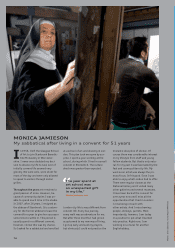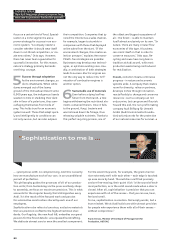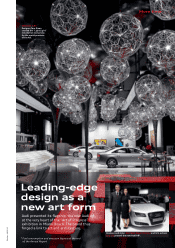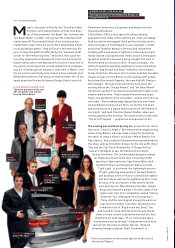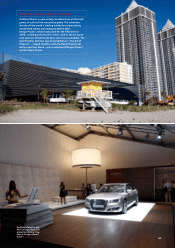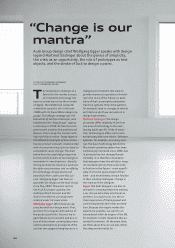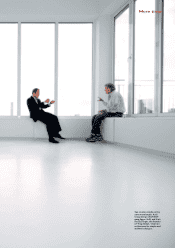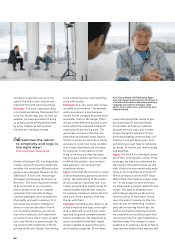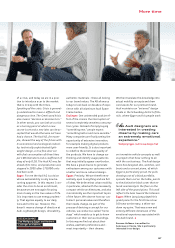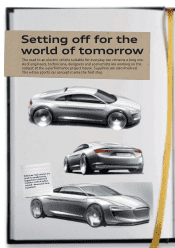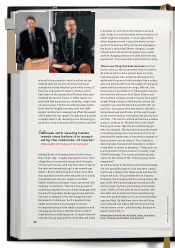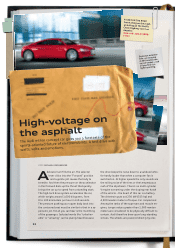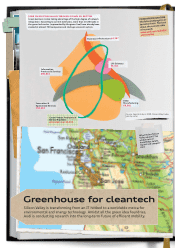Audi 2009 Annual Report Download - page 87
Download and view the complete annual report
Please find page 87 of the 2009 Audi annual report below. You can navigate through the pages in the report by either clicking on the pages listed below, or by using the keyword search tool below to find specific information within the annual report.
84
INTERVIEW/SUSANNE HOFBAUER
PHOTOS/DOMINIK GIGLER
he importance of design as a
factor for the market success
of innovative technology has
been no secret ever since the triumph
of Apple. The Californian computer
maker first caused a stir in the mid-
1980s with its Snow White design lan-
guage. This design strategy was the
brainchild of Hartmut Esslinger, who
established the “frog design” agency
in Germany in 1969. At the time com-
puters were unattractive professional
devices, their use by the masses noth-
ing more than a vision. Today Apple is
considered an example of how revolu-
tionary product concepts implemented
with uncompromising style can lead to
sustainable social change. The Audi
brand has also used design expertise
to channel its powers of technological
innovation in new directions. Socially,
driving an Audi has become a synonym
for style-consciousness and an affinity
for technology. Design prizes and
awards further underscore this suc-
cess. Wolfgang Egger has been re-
sponsible for design at the Audi Group
since May 2007. Showcars such as
the Audi A1 project quattro, the
Audi Sportback Concept and the
Audi e-tron electric car study were
created under his supervision.
Wolfgang Egger: We follow two ap-
proaches with our design work: First,
we strive for a logical continuation of
the product portfolio. Second, we re-
gard design as provocation and as a vi-
sion of how a team contemplates inno-
vations and explores all aspects of the
car that can suggest changing use or a
changing environment. We want to
provide answers to questions of mobil-
ity in the cities of the future, to ques-
tions of fuel consumption and poten-
tial drive systems. New drive systems,
for example, lead to changes in vehicle
architecture which we can explore in
design experiments.
Hartmut Esslinger: The design
processes differ relatively little from
one area of technology to the next –
leaving aside specific fields of exper-
tise. Technology is often much more
evolutionary than one thinks. Software
systems, for example, are nearly eter-
nal. The basic technology behind the
Macintosh operating system has been
continuously improved since 1984, but
in principle has not changed funda-
mentally. It is therefore imperative
that designers have the ability to imag-
ine multiple options that could come
to fruition in the future – more specifi-
cally, five to ten years ahead of their
time – and nevertheless remain flexible
in their creative strategies. Change is
the mantra of the designer.
Egger: We Audi designers are also in-
terested in creating dreams by making
a car into an extremely emotional ex-
perience. In a sports car, it is the ar-
chaic experience of feeling speed and
controlling lateral and linear accelera-
tion. Because the engine makes this
experience possible, we went to ex-
treme detail with the engine of the R8,
for example, to best maximize this po-
tential for emotion. At the same time,
we think about how we can also refine
this deep emotionality for
T
Audi Group design chief Wolfgang Egger speaks with design
legend Hartmut Esslinger about the genius of simplicity,
the crisis as an opportunity, the role of prototypes as test
objects, and the stroke of luck to design a piano.
“Change is our
mantra”


